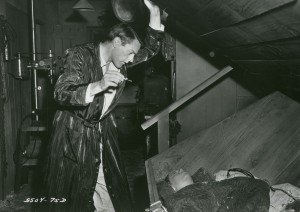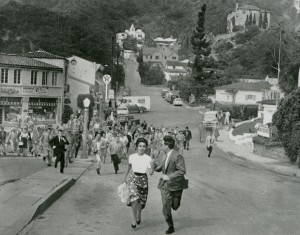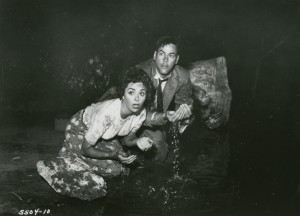by Barb Lentz.
The five movies Bob provided me from which to choose were these:
The Champ (1931)
Downhill Racer (1969)
Invasion of the Body Snatchers (1956)
The Postman Always Rings Twice (1946)
Seven Chances (1925)
I chose Invasion of the Body Snatchers due to its reputation. It has a very lurid title, as do so many monster movies of that era, and yet it is acknowledged as a serious film, unlike most of the others. Bob has told me different things about the movie over the years, so it was time to see it for myself.

A suburban doctor returns from vacation to find his town altered in certain aspects. Not the town itself, but its inhabitants. Patients claim that their relatives are no longer their actual relatives, that they are different somehow. The doctor (Kevin McCarthy) is even more surprised when some of the people who are so upset are no longer upset the next day, as if nothing were ever the matter. Suspicion grows within him, exploding when a friend, Jack (King Donovan), finds a “blank” body in his home. The blank’s features gradually fill in until it resembles Jack!
From here the story moves from personal paranoia to widening mystery as the doctor and his friends encounter the huge scope of the ever-growing conspiracy, which is eventually revealed to be, just as the title implies, an invasion from outer space. Only the invaders are not little green men from Mars or stupid-looking radish people from Venus; these invaders are soulless spores that land on fertile Earth and mimic the life they encounter so that they can rapidly and utterly conquer their new habitat.
The details of this invasion are far more realistic and convincing than most of the other monster movies Bob has made me watch over the years. But what really works is how the script forces its characters (and thus, the audience) to confront big questions regarding humanity and freedom and choice. Even though the pod people — the humans who have been “possessed” or “replaced” by the blank bodies created within the alien pods — profess to be happier without the constraints of emotion and feeling, we all know better. To lose one’s sense of self is to become lost, and no collective sentience can ever replace that.
My top five aspects of the movie are:

1. The setup of the initial mystery, when Dr. Bennell returns to town. It begins so modestly, in a way that seems inconsequential, then slowly begins to gather steam as evidence mounts that something sinister is afoot. Because the “pod people” still look and behave in the same ways as the people they “replace,” it is difficult to pinpoint the malady that troubles the town. Just as Dr. Bennell is confused, so is the audience.
2. The lack of emotion that marks the difference between the “pod people” and ordinary humans. It’s such a simple device, and yet it is most effective. Ultimate rationality is great if you are Data on Star Trek: The Next Generation, but we mortals depend on our emotions and feelings and intuitions and faiths to steer our lives. If we lose the intangible capabilities and potentials that we have, as triggered by those emotions and feelings, then we become nothing more than ants in a colony, one of millions doing and being the exact same thing.
3. How insidious this invasion is. Other alien invasions are blatant attempts to conquer our planet, from The War of the Worlds to Independence Day. This story is so powerful because it could happen anywhere, anytime, and most people would never notice, never even realize that they were being “replaced” until it was all over. The sheer audacity of spores from outer space with the potential to reproduce and mimic the life they encounter is absolutely remarkable.
4. I like how seamless and effective the filming technique is, how easily the tale is told, and in a very brief eighty minutes. The director, Don Siegel, obviously knows how to build suspense, how to keep the action moving, when to add music and how to coax performances out of his cast. This is a beautifully made film, without flashiness, that gets under your skin and stays there.

5. The flashback format, which starts at the finish, when we see Dr. Bennell as a crazy person about to be admitted to the psychiatric unit, and then allows him to tell his story from the beginning. This structure has become formulaic, if not a total cliché, in movies, but it really works in this instance. When we return to the finish, we totally understand why the doctor is as manic as he is. And when another patient tells the doctors about the truck that has spilled weird-looking pods all over the street, the relief is palpable, both for Dr. Bennell, and for the audience. It isn’t too late; something can still be done.
The script’s parallels to the threat of communism were indicated to me by Bob when we discussed the movie afterward, and I can see why, especially at the time, people saw such parallels. Even if the movie were not designed as an allegory regarding the loss of self at the hands of a collective unity such as communism, that is so intrinsic to its story it is almost subconscious. The great films usually have wider context, and this is certainly true here.
Is Invasion of the Body Snatchers a classic? Yes! It is as much a people film as Breaking Away or Gunga Din, even though it is science-fiction. The connection between friends, or characters who love each other, is paramount, and the story’s action occurs when those connections are broken or somehow threatened. The doctor is tied into the town so tightly that he identifies the threat, determines what it really is, and helps lead the fight against the insidious invaders. I’m not a big fan of science-fiction, but when a movie is this suspenseful and relevant, I can see why Bob is so taken by the genre. If only those silly monster movies were all this good . . .
BRL 11 December 2015.
Invasion of the Body Snatchers (February 5, 1956)
Walter Wanger Productions / Allied Artists
Directed by Don Siegel. Produced by Walter Mirisch.
Screenplay by Daniel Mainwaring, based upon a novel by Jack Finney.
Principal Cast (character, performer):
Dr. Miles Bennell Kevin McCarthy
Becky Driscoll Dana Wynter
Dr. Dan Kauffman Larry Gates
Jack Belicec King Donovan
Theodora “Teddy” Belicec Carolyn Jones
Nurse Sally Withers Jean Willes
Police Chief Nick Grivett Ralph Dumke
Wilma Lentz Virginia Christine
Mac Lomax Dabbs Greer
Dr. Hill Whit Bissell
Dr. Bassett Richard Deacon
Charlie Sam Peckinpah
80 minutes. Widescreen (1.85:1). Black and White. Not Rated.
